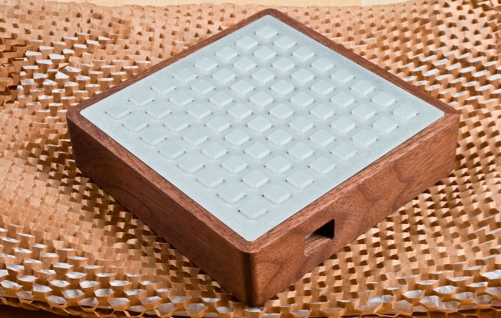Fresh out the box…
(This entry written for Martyn Ware… but could be useful to others…)
The monome.org site has lots of useful information, tutorials, apps and patches… but is, typically of open source communities (though better than most), messy and a bit difficult to find your way round if you’re new to it. The best place to start is the new monome docs and in particular the setup section…

To get the monome up and running you’ll need the following essential (E) and recommended (R) drivers & software:
1. (E) Install the ftdi virtual com port (vcp) driver.
2. (R) I use Hardware Growler “This is a little app hidden in the extras folder of the growl disk image. It notifies you of any hardware events, like when you plug in your mouse” which shows that the monome has been plugged in and is recognised by OS X. But you need to install Growl which actually gives notification of much more system activity – you can configure how much in the Growl preferences pane…
3. (E) monomeserial is an osc and midi router. “it’s needed to interface with our other applications and to make your monome device accessible via midi to other types of software.” This will show ‘no device detected’ if the driver isn’t installed properly.
4. (E) Most monome apps are written in MaxMSP (and Chuck to a lesser degree) – you’ll only need to download the Runtime version of MaxMSP – I personally wouldn’t bother with Chuck initially.
5. (R) the monome_base_4.4.zip file contains a collection of useful MaxMSP patches that can be used to test and configure the monome – there’s additional info on the how to use monome devices section.
If you get to here and are able to see lights on the device and button presses in the ‘monome_midi_64.mxb’ patch (for example) then everything is installed and configured properly… Now to move on…
6. (R) I think it’s worth deciding on a simple data structure to store and access files – I shared my setup on a thread on file management on the monome forum.
7. (E) You’ll need soft-synths and/or soft-samplers to receive MIDI and make sound… running Logic and some of its in-built instruments or as a VST/Audio Units host will do this obviously… but standalones are probably less demanding of system resources. I use Native Instruments’ Massive, Kontakt & Battery and (on Windows at least) the M1 from the Korg Legacy Digital Collection – up to you obviously. A good range of drum kits, piano, plucked strings and mallet/bell sounds are particularly useful…
8. (R) I use various MIDI utilities to monitor MIDI data, set up additional virtual MIDI ports, rig more complex MIDI routings etc… including the freeware MIDI Monitor and Midi Pipe – download it here. STEIM’s JunXion could be really useful here too… since it also reads OSC over USB.
9. (R) Here’s an application list of some of the most popular apps and patches. I’d recommend clear, mabalhabla, boiingg and flin for starters… also bends for tilt data…
Hope these notes help get you up and running… that Dave Hunt works with MaxMSP could be really useful I think – once you get more idea of what you could really use the monome for…